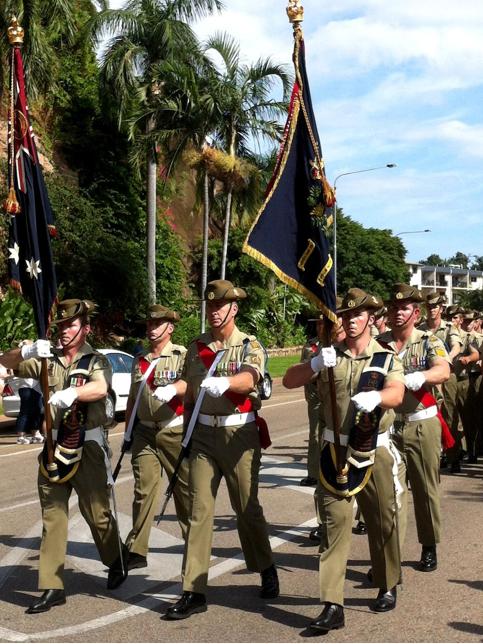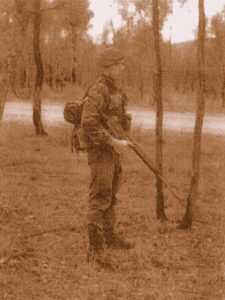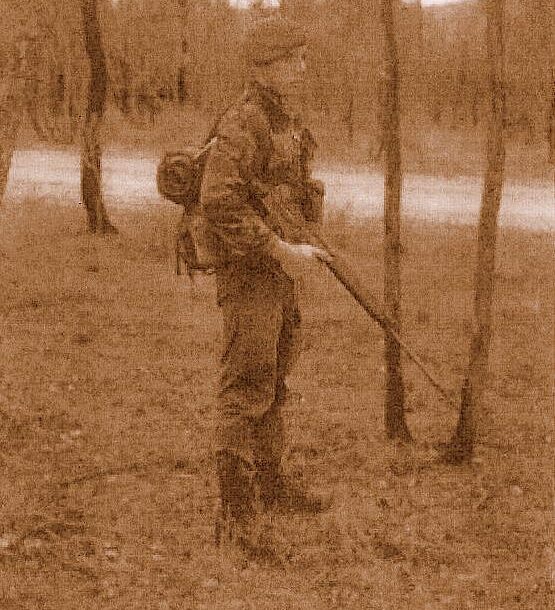In Julian Knight’s own words:
Introduction
I was born on 4 March 1968 in Melbourne, Australia. My father was an officer in the Royal Australian Army Education Corps (RAAEC) during 1968-1988. My earliest memories are of my father in uniform and the Centurion tanks at Puckapunyal, where we lived during 1970-1972. I attended kindergarten at Puckapunyal and later at RAAF Point Cook. I then attended primary school at Stanley Fort, Hong Kong, during 1973-1975.
I had wanted to enlist the Army for as long as I can remember. From around the age of 12 my ambition was to emulate my father and become an officer in the Australian Army. During my school years my goal was to attend the Officer Cadet School (OCS), at Portsea.
As a precursor to military service I was a Boy Scout in the 1st Point Cook Scout Troop at RAAF Point Cook during 1976-1979 (during the ages 8-11). I rose to be a “Sixer” in the Cubs and a “Pack Leader” in the Scouts. In my last year as a Cub, I was awarded the prize for the most badge work completed but I was also demoted from “Sixer” to “Seconder” after pushing over another Cub.
Cadet Service
During 1982-84 (ages 14-16), I served as a cadet in the Norwood High School Cadet Unit (NHSCU), although I was a student at Fitzroy High School during this time.
Whilst a cadet in the NHSCU, I attended two annual camps and two training weekends. I also completed junior NCO and senior NCO courses in 1983, and I rose to the rank of corporal. I also obtained the Adventure Training Award (ATA) in 1983. The Cadet Under Officer (CUO) of the NHSCU Senior Platoon in 1983 was CUO Jason THOMAS (CSC No 4758), who attended RMC/ADFA during 1984-86 and who was a 2nd Class cadet at Duntroon in January 1987.
During 1984-85 (ages 16-17), I served as a cadet in the Melbourne High School Cadet Unit (MHSCU) after transferring from the NHSCU. I kept the rank of corporal when I transferred from the NHSCU.
In mid-1984, I was discharged from the MHSCU after failing to attend a training weekend. I was later allowed to re-join the MHSCU but I was forced to forego my rank. I served as a cadet for the remainder of my time with the MHSCU. I served in the unit’s 5 Platoon, the “adventure training” platoon (and also the platoon for demoted cadets or those cadets expelled from other platoons). The platoon leader and platoon sergeant of 5 Platoon in 1983 were CUO Dechlan ELLIS (CSC No 5693) and Patrick “Pat” BELL (CSC No 5678), both of whom (along with three other Melbourne High School cadets) attended the Australian Defence Force Academy in 1986.
Whilst a cadet in the MHSCU, I attended two annual camps and two training weekends, and three training weekends with the 4th/19th Prince of Wales’s Light Horse Regiment.
During my service as a cadet, I marched as a guidon bearer in the ANZAC Day parades in Melbourne in 1983, 1984 and 1985.

On 28 July 1985 (at age 17), I applied for entry into the January 1986 intake of the Australian Defence Force Academy (ADFA). At the examination day on 13 August 1985, I was deemed to be not academically strong enough for ADFA, and I was told to re-apply for entry into the Royal Military College, Duntroon, (RMC Duntroon) as soon as I was old enough (* Duntroon candidates had to be at least 18½ years old upon entry to the college). The final recommendation of the army psychologist, Captain J.R. WARN, was recorded as being that I needed ‘more development. e.g. work for a year after HSC, ARES, and he could be a good prospect for RMC. Too weak academically for D.A.’
In November 1985, I completed my Higher School Certificate (HSC) at Melbourne High School. I was subsequently awarded my HSC in January 1986, with C-grade passes in five subjects (English, Australian History, 18th Century History, Geography, and Politics) and with an Anderson Score of 271/410.
Army Reserve Service
On 1 October 1985 (at age 17), I applied for enlistment into the Australian Army Active Reserve whilst still at school. I was subsequently enlisted as a private on 26 November 1985. From 4 December 1985 to 12 January 1987, I served as a trooper in the 4th/19th Prince of Wales’s Light Horse Regiment (4th/19th PWLH).
In February 1986, I worked briefly as a door-to-door promoter. During March-May 1986, I attended La Trobe University in Melbourne as an undergraduate student in the Bachelor of Arts degree course. For the remainder of 1986 I was unemployed and devoted most of time to Army Reserve service. During 1986, I served over the maximum 100 training days allocated to Reservists.
I attended my 16-day Army Reserve Recruit Course in February 1986 (at age 17), an Assault Troopers Course in April 1986 (at age 18), an A Vehicle (Armoured Personnel Carrier) Drivers Course during April-May 1986, and a Radio Operators Course in October 1986. I obtained above average marks in all categories of assessment in my Recruit and Assault Troopers courses. I initially did well on my A Vehicle Drivers Course, being one of two students to give a driving demonstration to a local TV news crew, but I developed a personality clash with my ARA instructor and I was later ejected from and subsequently failed the course. I was the Student of Merit for my Radio Operators Course.
During 1-15 February 1986, I attended my Recruit Course at the Army Reserve’s 3 Training Group at Puckapunyal. I passed all the tests and examinations, and I was the top recruit in my platoon with ratings of ‘1’ in all the assessment categories (‘1’ being the highest grade on a scale of 4 – Unsatisfactory, 3 – Below Average, 2 – Average & 1 – Above Average).
I attained all 1 ratings when assessed at both the end of week one and at the conclusion of the course, with the assessment categories being the following: acceptance of discipline, self-discipline, teamwork, determination, navigation, dress and bearing, personal organization, drill at halt, drill on march, weapons, field training, and physical assessment. I passed my Physical Training Test (PTT) (* Which had to be completed by all Army personnel on an annual basis and which required the completion of: 60 sit-ups in 2 minutes, 7 complete chin-ups to a high bar and a 5km run in under 25 minutes) with a high B grade, and I ran the 5km run portion of the PTT in 19:45 minutes.
My platoon commander, 2nd Lieutenant Max DE WAN, made the following Course Final Assessment: ‘REC [Recruit] KNIGHT achieved good results throughout the course. He worked hard to assimilate the training. REC KNIGHT invariably participated in platoon activities with enthusiasm. His dress and bearing was adequate but there was room for improvement in this area. REC KNIGHT displayed a good acceptance of self and military discipline. His physical fitness and co-ordination was good.’
During 4-20 April 1986, I attended my Assault Troopers Course at Site 6, Puckapunyal. The course’s Senior Instructor, Captain G.L. SMITH, made the following comments in my Course Report: ‘Tpr [Trooper] Knight was adequately prepared for the course. He participated in all course activities. He readily assimilated most instruction with ease and rarely required additional assistance. His dress and bearing was adequate.’
During 26 April-11 May 1986, I attended my A Vehicle (M113 APC) Drivers Course at 4th/19th PWLH’s A Squadron depot in Sale and at the Dutson bombing range. I grasped the driving aspects of the course quite quickly but I developed a personality clash with my ARA instructor, Sergeant Gary WYND. On 6 May 1986, I failed the verbal test on Instant Panel Reactions.
On 7 May 1986, the twelfth day of the 16-day course, I failed the re-test. Failing this re-test effectively meant that I had failed the entire course.
That afternoon a regional TV station sent a reporter and a camera crew to the Dutson range to file a story on the A Vehicle Drivers Course. The training was suspended while two APCs were used to provide a demonstration of the recovery of an APC from a bog, and a display of cross-country driving. Two trainees were required to drive the two APCs used throughout the demonstration and the driving display. The two trainees chosen by the course’s Senior Instructor, Lieutenant O’DOWD, were Lance-Corporal BROWN, who later won the course’s Student of Merit award, and me. The TV crew filmed the recovery demonstration and the display of cross-country driving. During the cross-country driving demonstration, the TV crew filmed me driving my APC from the back of Lance-Corporal BROWN’s APC.
The story was broadcast that night during the TV station’s evening news broadcast. The following morning I was seen by the driving course’s ARA Trade Testing Officer (TTO), WO2 Kevin HUNTER, in one of the offices at the barracks. HUNTER informed me that I was being thrown off the drivers course because I had failed my Instant Panel Reactions re-test. Sergeant WYND made the following comments in my Course Report: ‘Tpr Knight approached the course with an immature attitude. During the course he did not apply himself and required constant supervision. He lacks mechanical aptitude and will find this aspect difficult to improve unless he is prepared to get himself dirty rather than watch others work. Although he grasped the techniques of driving early in the course, he developed a brash and overconfident manner which at times placed both vehicle and crew in jeopardy.’
During 3-19 October 1986, I attended my Radio Operators Course at Sale. I was the course’s Student of Merit on the basis of my ‘hard work, determination and responsibility.’ The course’s Senior Instructor, Lieutenant CHAMBERS, made the following comments in my Course Report: ‘Tpr KNIGHT was adequately prepared for the course. He worked well throughout to achieve good results. He is determined, aggressive in his studies and seeks responsibility. Tpr KNIGHT has a good knowledge of all subjects. To attend the next available A VEH D & S [Driving and Servicing] Course.’ During the course I passed my PTT with a high A grade.
During my service with the 4th/19th PWLH Regiment I attended weekly training nights and various training weekends, and a number of Freedom of Entry and other ceremonial parades. I also volunteered for camp advance parties, dining-in nights and general full-time service both with 4th/19th PWLH and at Armoured Centre, Puckapunyal.
In November 1986, I attended the 4th/19th PWLH Regimental Annual Range Shoot weekend at Puckapunyal, and attained the highest score in the Regiment with the L1A1 Self-Loading Rifle.
In November 1986, I also represented the 4th/19th PWLH Regiment in the annual 3rd Military District Army Reserve Inter-Unit Military Skills Competition at Fort Gellibrand, Williamstown.

